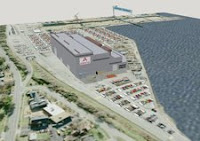 Yesterday's announced deal between AREVA and Northrop Grumman to build a $363 million nuclear reactor manufacturing plant in Newport News, VA is getting a whole lot of media attention.
Yesterday's announced deal between AREVA and Northrop Grumman to build a $363 million nuclear reactor manufacturing plant in Newport News, VA is getting a whole lot of media attention.The New York Times says Nuclear Power May Be in Early Stages of a Revival.
...Not since 1973 had anybody in the United States ordered a nuclear plant that was actually built, and the obstacles to a new generation of plants seemed daunting.Fortune magazine weighs in, Nuclear power revival gets big lift
But now, according to the Nuclear Regulatory Commission, 21 companies say they will seek permission to build 34 power plants, from New York to Texas. Factories are springing up in Indiana and Louisiana to build reactor parts. Workers are clearing a site in Georgia to put in reactors. Starting in January, millions of electric customers in Florida will be billed several dollars a month to finance four new reactors.
On Thursday, the French company Areva, the world’s largest builder of nuclear reactors, and Northrop Grumman announced an investment of more than $360 million at a shipyard in Newport News, Va., to build components for seven proposed American reactors, and more for export.
The change of fortune has come so fast that the Nuclear Regulatory Commission, which had almost forgotten how to accept an application, has gone into a frenzy of hiring, bringing on hundreds of new engineers to handle the crush of applications.
The announcement follows one earlier this summer by The Shaw Group and Westinghouse of their plans to build a nuclear components plant in Louisiana. Both are important steps toward what AREVA chief executive Anne Lauvergeon, in an exclusive interview with Fortune before the announcement, described as “reviving the capacity of the nuclear industry in the U.S.”Unsurprisingly, the deal made page one of the local, the Newport News Daily Press: 540 jobs, $363 million in nuclear reactor deal
"It enables, on the footprint of the shipyard, a new technology, a new form of production," said Gov. Timothy M. Kaine. "Shipbuilding is a massive industry. It has some cycles associated with it. But to have this technology at the shipyard location ... is a great thing for that shipyard."WVIR, the NBC affiliate in Charlottesville, has the video of Governor Kaine's announcement at the Capitol in Richmond.
The building where the joint venture will do the work will be constructed in the north end of the shipyard where there is currently a large parking lot. The companies make the large components, but not handle any radioactive nuclear materials, that will be used to construct a wave of planned reactors nationwide.
The move will further strengthen Virginia's position as a leader in nuclear technology and bring high-paying engineering and advanced manufacturing jobs to Newport News. Construction of the facility, which will help Northrop Grumman be less dependent on federal spending cycles that can lead to the loss of skilled employees, will start in March 2009.
"This gives us a chance to diversify a little bit and allow us to smooth more of that out," said Mike Petters, president of Northrop Grumman Shipbuilding. "We don't see this as interfering with anything we do on the Navy side. In fact, we think it compliments it very well."
Comments